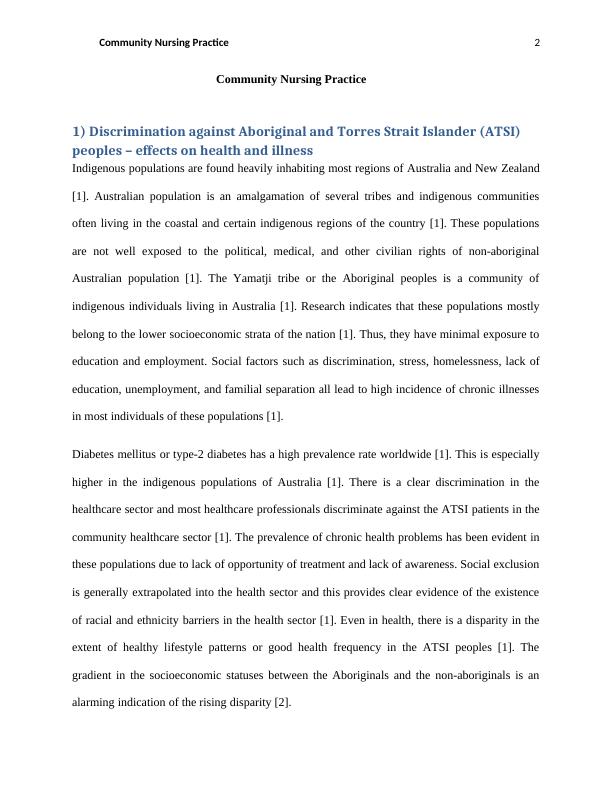Ask a question from expert
Community Nursing Practice
8 Pages2309 Words223 Views
Added on 2019-12-17
Community Nursing Practice
Added on 2019-12-17
BookmarkShareRelated Documents
Community Nursing Practice1Community Nursing PracticeAssessment Task 1Student's Name:Instructor's Name:Date:

Community Nursing Practice2Community Nursing Practice1) Discrimination against Aboriginal and Torres Strait Islander (ATSI) peoples – effects on health and illnessIndigenous populations are found heavily inhabiting most regions of Australia and New Zealand[1]. Australian population is an amalgamation of several tribes and indigenous communitiesoften living in the coastal and certain indigenous regions of the country [1]. These populationsare not well exposed to the political, medical, and other civilian rights of non-aboriginalAustralian population [1]. The Yamatji tribe or the Aboriginal peoples is a community ofindigenous individuals living in Australia [1]. Research indicates that these populations mostlybelong to the lower socioeconomic strata of the nation [1]. Thus, they have minimal exposure toeducation and employment. Social factors such as discrimination, stress, homelessness, lack ofeducation, unemployment, and familial separation all lead to high incidence of chronic illnessesin most individuals of these populations [1].Diabetes mellitus or type-2 diabetes has a high prevalence rate worldwide [1]. This is especiallyhigher in the indigenous populations of Australia [1]. There is a clear discrimination in thehealthcare sector and most healthcare professionals discriminate against the ATSI patients in thecommunity healthcare sector [1]. The prevalence of chronic health problems has been evident inthese populations due to lack of opportunity of treatment and lack of awareness. Social exclusionis generally extrapolated into the health sector and this provides clear evidence of the existenceof racial and ethnicity barriers in the health sector [1]. Even in health, there is a disparity in theextent of healthy lifestyle patterns or good health frequency in the ATSI peoples [1]. Thegradient in the socioeconomic statuses between the Aboriginals and the non-aboriginals is analarming indication of the rising disparity [2].

Community Nursing Practice3Reading and Wien (2009), note that social determinants play a vital role in the health, wellness,and in illnesses amongst people [2]. Reading and Wien additionally note that in countries such asAustralia and Canada, the indigenous peoples are an integral part in the socio-political context[2]. These populations have belief systems that revolve around holistic healing which tends toaffect the frequency of their attendance to clinical medicine [2]. Vos et al (2009), indicate that colonization in Australia has led to certain governmentalregulations and policies that are discriminatory to the aboriginals and the indigenouscommunities of the Australian region [1]. Due to this, there has been ill-treatment of a physicalnature, disruption of their social settings, decline in the indigenous population, dispossession ofassets, and exploitation in the fields of economy and education [1]. Vos et al (2009) note thatthere has been ‘codified discrimination’ along with disruption of everyday life for these peoples[1]. This has an inevitable impact on the health and illness statistics of these populations [1]. Thesocial discriminating factors have led to worsening of health graphs and jeopardy of healthylifestyles [1]. Research indicates that illnesses are far more common amongst indigenouspopulations rather than amongst the non-indigenous population in the Australian and NewZealand regions [1]. This is, in fact, a direct consequence of the disparity that exists amongst thehealthcare workers and the unavailability of healthcare services [1]. Diabetes and chronic kidneydiseases are the most common occurrences amongst the indigenous groups according to thesurveys conducted by the Australian governmental health organizations [1]. Two research efforts by Reeve et al (2014) and Minges et al (2011) respectively discuss thevarious aetiological determinants of chronic illness (diabetes) in the indigenous populations ofAustralia [3]. Reeve et al, (2014), note that the prevalence of type 2 Diabetes is considerablyhigh within individuals of the Aborginal community of Australia [3]. Amongst the population of

End of preview
Want to access all the pages? Upload your documents or become a member.
Related Documents
Health Services for the ATSI and the Anglo-Australian Communitieslg...
|11
|2905
|165
Community Nursing Practice - Assignmentlg...
|9
|2517
|178
Social Determinants of Health (SDOH) in Australialg...
|16
|3844
|153
Tobacco Health Inequity in Australialg...
|12
|3617
|247
Closing The Gap (CTG) Policy and its Significance to Indigenous Australianslg...
|9
|2346
|488
ATSI Health: Primary Health Services, Disparities, and Factors Influencing Delivery | Overview and Analysislg...
|8
|2261
|180